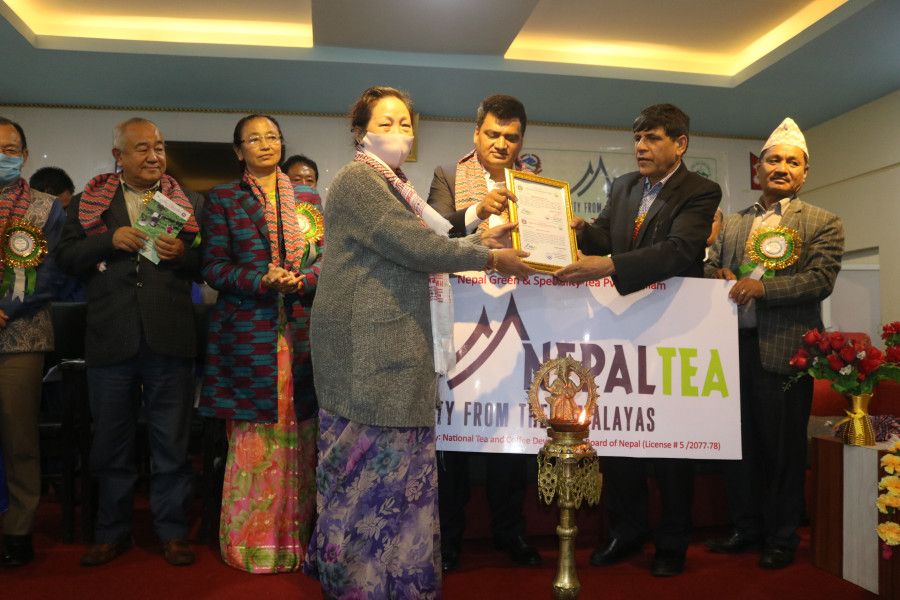Money
Nepal's orthodox tea gets its own trademark
The trademark includes the words 'Nepal Tea Quality from the Himalaya'.
Biplav Bhattarai
Nepal's orthodox tea got its own trademark on Tuesday, 157 years after the country started growing it.
The trademark includes the words 'Nepal Tea Quality from the Himalaya'. Launched two years ago and formally executed on Tuesday, it is the first brand of agriculture produce in the country.
The trademark is expected to help Nepal brand and market its tea, which has been facing an identity crisis for over a century, in the international market.
Minister for Agriculture and Livestock Development Ghanashyam Bhusal handed over the trademark certificates to 12 tea factories and cooperatives in Fikkal, Ilam on Tuesday which have adhered to the Nepal Orthodox Tea Certification Trademark Directive 2018.
Trademark is basically registering a brand name. Now it is possible to have the legal right to stop someone else from using the same or similar brand as the one that has been registered. Trademark serves as a defence mechanism to protect a brand from loss of reputation, and has the potential to increase in value as an intangible asset.
Nepali orthodox tea has been gaining popularity in the international market because of its quality, aroma, taste and aftertaste. But other popular tea brands, such as Darjeeling tea, overshadow the Nepali product abroad due to lack of branding, according to Nepali traders.
Bishnu Prasad Bhattarai, executive director of the National Tea and Coffee Development Board, said 42 factories had applied for the trademark but only 12 qualified based on the code of conduct for producing organic tea.
“This is the beginning. Other producers will also soon get the certificate if they fulfil the requirements.”
He added that the trademark would help traders gain international market access.
Tea producers said that a decade-long discussion regarding implementation of the Nepal tea trademark had been resolved. The collective trademark will work as a tool to brand the product abroad, and help Nepali tea producers to expand their footprint in the global orthodox tea market, they said.
“With the implementation of the trademark, it has opened the door for Nepali traders to market their products in the international market,” said Bhusal. “Tea is the first product to get a trademark among agricultural commodities. We will soon be introducing the international trademark of Nepali ginger.”
Nepal has a long history of tea cultivation. The first Ilam Tea Estate in the hills of Ilam district was initiated in 1863. Historians believe that the first tea bushes in Nepal were grown from seeds which were given as a gift by the Chinese emperor to the then prime minister Jung Bahadur Rana.
It is believed that tea plantations in Nepal started within the same decade, when it was introduced in the Darjeeling Hills of India.
In 1965, a second tea plantation, Soktim Tea Estate, was set up in the plains of Jhapa district.
Province 1 Minister for Land Management, Agriculture and Cooperatives Ram Bahadur Magar said that execution of the trademark alone would not improve Nepal’s tea market. “We have to produce more organic tea.”
According to the board, among the 12 factories that have obtained the certificates, nine are from Ilam—Sandakphu Tea Processors, Himalayan Shangri La Tea Producers, High Hill Tea Producer Cooperative Society, Jasbire Tea Prasodhan, Gorkha Tea Estate, Nepal Green Tea and Speciality Tea, Oasis Tea Industries, Taragaun Tea Estate and Sakejung Hill Range Tea Processing Industry.
Two of the factories—Bokre Dada Orthodox Chiya Prasodhan Udhyog and Singhadevi Tea Producers Cooperative—are from Tehrathum, and one factory—Sagarmatha Tea Estate—is from Sankhuwasabha.
Tea is grown in Nepal at elevations ranging from 800 to 2,200 metres above sea level. Previously, production was centred in a few districts like Ilam and Jhapa in eastern Nepal. Of late, tea gardens have been flourishing in other parts of the country too. Currently, the tea acreage totals 28,700 hectares.
Nepal produces around 6,097 tonnes of orthodox tea annually in the hills. It also produces 19,108 tonnes of crush-tear-curl (CTC) tea, known for its strong and bright appearance, in the lowlands of the Tarai.
According to the Trade and Export Promotion Centre, Nepal's tea exports saw a 13.14 percent drop to Rs2.78 billion in the last fiscal year 2019-20 from Rs3.20 billion in the previous fiscal year.
The National Tea and Coffee Development Board said shipments fell mainly due to increased domestic consumption of orthodox tea in recent years, inability to meet the latest tea standards set by the international market and lack of branding.




 7.12°C Kathmandu
7.12°C Kathmandu














